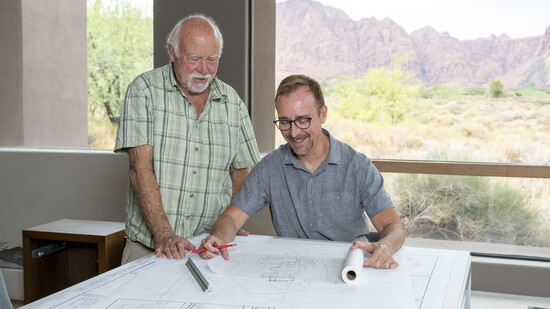Roughly translated, the Navajo word Kayenta means “water-bearing rock.” No term more perfectly embodies the beauty—and the biggest challenge—faced by the early developers of one of southern Utah’s most glittering jewels.
When architect Terry Marten first glimpsed the former Joy Peterson Ranch in the early 1970s, he was entranced. Frequently commuting between his clients in Utah—including the fledgling Brian Head Resort—and his home base in San Diego, Terry became familiar with every property along Highway 91. As soon as he heard the ranch near Ivins was up for sale, he rounded up a group of investors and inked the deal. With his artist’s eye, he envisioned a community of airy desert dwellings that would complement the land.
The 1,400-acre parcel had much to recommend it: Towering, spectacular views of red rock formations. Open, untouched spaces. Sparkling night skies.
What it didn’t have: water.
Terry, however, was undaunted. “Everyone knew Californians were crazy,” he laughs. “People said, ‘didn’t anyone tell you that the place didn’t have as much as one share of an irrigation ditch?’”
But Terry’s recent work at Brian Head, where water, sewage and septic systems had to be brought in, provided the expertise needed to resolve the dilemma. He requested a lease (in perpetuity) of the Ence wells; with Ivins City as a sponsor, the deal was approved. Next, Terry set about creating the infrastructure needed to bring water onto the property.
“That got the ball rolling, where he could start thinking about developing it because there was a water source,” recalls Matt Marten, Terry’s son and now business partner in Gulch Design Group, which provides design services for Kayenta residents. Then a middle school student, Matt admits that his first glimpse of the property wasn’t exactly positive. “I thought, ‘why are we here? It’s really hot, and it’s very orange and odd.’ As I got older, I was majoring in theater at Cal State Fullerton. I had no intention of coming to Utah and working with my dad.”
Matt hoped for a career in production, costume and set design. But out of practicality, architecture and design became his future path. As Terry began building homes, he tapped Matt to bring his artistic aesthetic to the task. It proved to be a winning solution, helping to refine the “Kayenta Concept” devised by Terry and another young architectural student, Jay Vanos.
The tenets of the concept are simple: Low-profile structures protect views. A neutral color palette for all materials blends into the natural setting. Focused lighting protects the night skies. Most importantly, the natural landscape must be preserved. Thus, all projects limit the amount of area which can “disturbed” on each parcel.
“Builders must leave anywhere from 60 to 75 percent of each property in its natural state,” Matt notes. “We sold land, but we also asked the owners of those properties to become stewards of the land. The whole idea was, we knew we had limited water, so we were always watching how much we used. We still are.”
Today, Kayenta boasts close to 800 homes that reflect the Martens’ artistic influences and their desire to serve a diverse, creative population. The community is home to the Center for the Arts at Kayenta, the bustling Kayenta Art Village, swimming pools, pickleball courts and much more—including popular eateries Xetava Gardens Café and Rusted Cactus.
Says Matt, “Food is an important part of our community, and food culture in America has really grown in the past 50 years. We love the idea of creating hubs where people can gather, sit across from each other and talk.”
Even as the entire southwest faces ongoing water crises, the Martens continue their careful, informed development of Kayenta. With the community’s 50th anniversary next year, they are justifiably proud of their track—and look forward to the next 50.
“My dad has always wanted to protect the environment, and this site,” Matt notes. “His intention with Kayenta will always be to do the best job possible, without putting the land in jeopardy.”
For more information, visit kayentautah.com.
Marianne Hamilton is a lifelong journalist whose work has appeared in regional and national publications.
